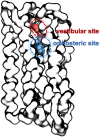Bitter Taste and Olfactory Receptors: Beyond Chemical Sensing in the Tongue and the Nose
- PMID: 34173018
- PMCID: PMC8231087
- DOI: 10.1007/s00232-021-00182-1
Bitter Taste and Olfactory Receptors: Beyond Chemical Sensing in the Tongue and the Nose
Abstract
The Up-and-Coming-Scientist section of the current issue of the Journal of Membrane Biology features the invited essay by Dr. Mercedes Alfonso-Prieto, Assistant Professor at the Forschungszentrum Jülich (FZJ), Germany, and the Heinrich-Heine University Düsseldorf, Vogt Institute for Brain Research. Dr. Alfonso-Prieto completed her doctoral degree in chemistry at the Barcelona Science Park, Spain, in 2009, pursued post-doctoral research in computational molecular sciences at Temple University, USA, and then, as a Marie Curie post-doctoral fellow at the University of Barcelona, worked on computations of enzyme reactions and modeling of photoswitchable ligands targeting neuronal receptors. In 2016, she joined the Institute for Advanced Science and the Institute for Computational Biomedicine at the FZJ, where she pursues research on modeling and simulation of chemical senses. The invited essay by Dr. Alfonso-Prieto discusses state-of-the-art modeling of molecular receptors involved in chemical sensing - the senses of taste and smell. These receptors, and computational methods to study them, are the focus of Dr. Alfonso-Prieto's research. Recently, Dr. Alfonso-Prieto and colleagues have presented a new methodology to predict ligand binding poses for GPCRs, and extensive computations that deciphered the ligand selectivity determinants of bitter taste receptors. These developments inform our current understanding of how taste occurs at the molecular level.
Keywords: Bitter taste; Chemosensory receptors; ORs; Odorant; Olfaction; TAS2Rs.
© 2021. The Author(s).
Conflict of interest statement
The authors have no conflicts of interest to declare that are relevant to the content of this article.
Figures

Similar articles
-
Taste and smell GPCRs in the lung: Evidence for a previously unrecognized widespread chemosensory system.Cell Signal. 2018 Jan;41:82-88. doi: 10.1016/j.cellsig.2017.02.002. Epub 2017 Feb 4. Cell Signal. 2018. PMID: 28167233 Free PMC article. Review.
-
Beyond the Flavour: The Potential Druggability of Chemosensory G Protein-Coupled Receptors.Int J Mol Sci. 2019 Mar 20;20(6):1402. doi: 10.3390/ijms20061402. Int J Mol Sci. 2019. PMID: 30897734 Free PMC article. Review.
-
Promiscuity and selectivity of bitter molecules and their receptors.Bioorg Med Chem. 2015 Jul 15;23(14):4082-91. doi: 10.1016/j.bmc.2015.04.025. Epub 2015 Apr 16. Bioorg Med Chem. 2015. PMID: 25934224
-
The gut odorant receptor and taste receptor make sense of dietary components: A focus on gut hormone secretion.Crit Rev Food Sci Nutr. 2024;64(20):6975-6989. doi: 10.1080/10408398.2023.2177610. Epub 2023 Feb 13. Crit Rev Food Sci Nutr. 2024. PMID: 36785901 Review.
-
Comparing Class A GPCRs to bitter taste receptors: Structural motifs, ligand interactions and agonist-to-antagonist ratios.Methods Cell Biol. 2016;132:401-27. doi: 10.1016/bs.mcb.2015.10.005. Epub 2015 Dec 24. Methods Cell Biol. 2016. PMID: 26928553
Cited by
-
Machine Learning-Based Modeling of Olfactory Receptors in Their Inactive State: Human OR51E2 as a Case Study.J Chem Inf Model. 2023 May 22;63(10):2911-2917. doi: 10.1021/acs.jcim.3c00380. Epub 2023 May 5. J Chem Inf Model. 2023. PMID: 37145455 Free PMC article.
-
Effect of single-administration of D-sorbitol pretreatment on the bitterness and continued willingness to take asenapine: a randomized, single-blind, placebo-controlled, crossover trial.BMC Psychiatry. 2024 Jan 30;24(1):81. doi: 10.1186/s12888-024-05549-x. BMC Psychiatry. 2024. PMID: 38291403 Free PMC article. Clinical Trial.
-
Sensory evaluation of the bitterness of asenapine using D-sorbitol pretreatment: single-blind, placebo-controlled, crossover trial.BMC Psychiatry. 2023 Mar 14;23(1):159. doi: 10.1186/s12888-023-04664-5. BMC Psychiatry. 2023. PMID: 36918838 Free PMC article. Clinical Trial.
References
-
- Ahmed L, Zhang Y, Block E, Buehl M, Corr MJ, Cormanich RA, Gundala S, Matsunami H, O'Hagan D, Ozbil M, Pan Y, Sekharan S, Ten N, Wang M, Yang M, Zhang Q, Zhang R, Batista VS, Zhuang H. Molecular mechanism of activation of human musk receptors OR5AN1 and OR1A1 by (R)-muscone and diverse other musk-smelling compounds. Proc Natl Acad Sci USA. 2018;115(17):E3950–E3958. doi: 10.1073/pnas.1713026115. - DOI - PMC - PubMed
-
- Alexander SPH, Christopoulos A, Davenport AP, Kelly E, Mathie A, Peters JA, Veale EL, Armstrong JF, Faccenda E, Harding SD, Pawson AJ, Sharman JL, Southan C, Davies JA, Collaborators CGTP. The concise guide to pharmacology 2019/20: G protein-coupled receptors. Br J Pharmacol. 2019;176(Suppl 1):S21–S141. doi: 10.1111/bph.14748. - DOI - PMC - PubMed
Publication types
MeSH terms
Substances
LinkOut - more resources
Full Text Sources

